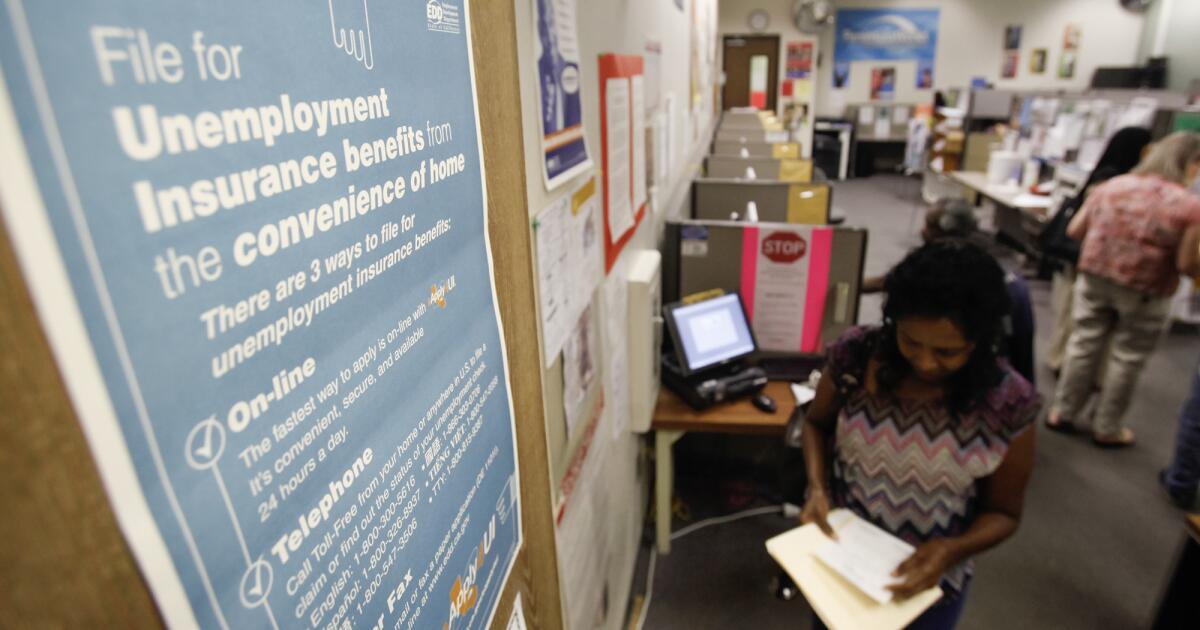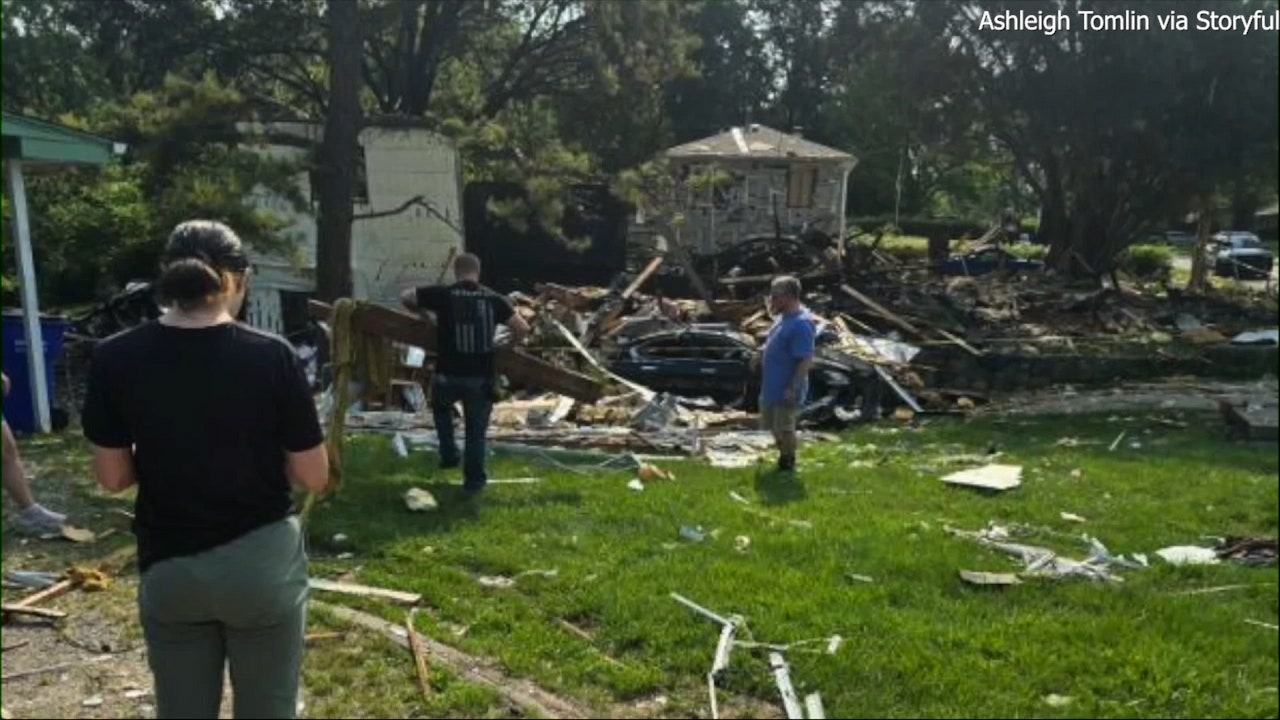Business
As job growth in California falls back, unemployment rate remains highest in the country

California posted another month of anemic job growth in April, keeping the state’s unemployment rate the highest in the country, 5.3%, the government reported Friday.
Statewide, employers added a net of just 5,200 jobs in April, down from 18,200 in March, according to California’s Employment Development Department.
Nationwide, employers added 175,000 jobs in April and 315,000 in March. The U.S. unemployment rate in April was 3.9%.
Major sectors of California’s economy — including manufacturing, information and professional and business services — showed job losses last month, and job opportunities aren’t as plentiful as before, even as the number of unemployed workers in the state has risen by 164,000 over the last 12 months.
In California, there were 140 unemployed workers for every 100 job openings in March, according to federal statistics released Friday. Less than two years ago, there were about two openings for every jobless person.
Carol Jackson, an unemployed worker in South Los Angeles, says she has been pounding the pavement for months, hoping to make use of her recently minted associate degree in web management and database administration. But despite sending her resume to at least 100 employers, she has not had a single interview.
“I can tell you that California is pretty brutal now,” said Jackson, 57.
Hiring in California has been lagging behind national trends, with one notable exception. The state’s healthcare and social assistance sector added 10,100 jobs last month, bringing the gains over the last 12 months to about 155,000. That’s 75% of all new jobs added since April 2023.
Hospitals and doctors’ offices have been bulking up, but the fastest growth has been at outpatient centers, home healthcare firms, nursing facilities and, especially, social assistance, which includes vocational rehabilitation and child day-care services.
“Healthcare is the big gorilla in the room; it dominates everything,” said Mark Schniepp, director of the California Economic Forecast in Santa Barbara, adding that it’s likely to keep growing robustly with new and expanded medical facilities across the state.
Leisure and hospitality businesses added 3,100 jobs last month. The gains included employment at hotels and restaurants — despite the added stress employers are feeling from a minimum wage increase to $20 an hour for fast-food workers that went into effect April 1.
While there are fears of layoffs as the food industry adopts technology to replace workers, California’s restaurants are getting a lift from a pickup in tourism. The leisure sector overall is close to fully recovering from the deep losses caused by the COVID-19 pandemic.
Public-sector payrolls also held up well last month, increasing by 2,600. Thus far, state and local government jobs seem to be showing little effects from California’s massive budget deficits.
“But clearly that will be another factor,” said Sung Won Sohn, economics professor at Loyola Marymount University in Los Angeles.
Sohn and other economists worry that there are national, cyclical and state-specific threats to California’s employment and broader economic outlook.
Key pillars of the state’s economy continue to struggle.
Motion picture producers and other employers in the information sector show few signs of breaking out of the hiring doldrums, despite the film industry’s resolution of labor strikes last fall. Los Angeles’ motion picture and recording studio industries were down by 13,400 employees, or 12%, in April compared with the same month a year earlier. And many workers in the industry say conditions do not appear to be improving.
Large parts of the farm economy in the Central Valley remain sluggish, in part due to rising costs, tighter financial conditions and ongoing climate challenges.
Despite strong investments in artificial intelligence, layoffs have persisted at high-tech firms in the Bay Area and elsewhere. Scientific and technical companies shed jobs last month, and employment at computer systems design work and related services has been gradually declining.
Nationally, economists expect job growth to slow in the coming months, the result of persistently high interest rates and an expected pullback from consumers. The outlook is particularly dim in California.
“On the ground, there are several signs of even more slowdowns,” said Michael Bernick, an employment lawyer at Duane Morris in San Francisco and former director of the state’s EDD. Among them, he said, “small businesses continue to struggle statewide with higher prices and tightened consumer spending.”
He and other experts have a similar refrain about what ails the state: high costs, excessive regulation and unaffordable home prices, among other factors.
“We just have real challenges here in California that other states don’t face,” said Renee Ward, founder of Seniors4Hire.org, a Huntington Beach-based organization that helps older workers find employment.
She said the number of job seekers registered with her service has jumped 26% so far in 2024 from a year ago.

Business
L.A. wildfire victims uncertain about returning to their burned neighborhoods

A new survey of victims of the Palisades and Eaton fires shows most would like to return to their old neighborhoods, but they’re worried that government officials can’t make it happen soon enough.
The vast majority of burned-out homeowners surveyed said they intend to rebuild the homes destroyed in the devastating January fires — yet half say they are unwilling to wait more than three years to return.
Urgency on all fronts is paramount to a successful revival of the lost neighborhoods, Los Angeles real estate developer Clare De Briere said.
She helped oversee the survey conducted by Project Recovery, a group of public and private real estate experts who compiled a report in March on what steps can be taken to speed revival as displaced residents weigh their options to return to Pacific Palisades, Altadena, Malibu and other affected neighborhoods.
The report was compiled by professors in the real estate graduate schools at USC and UCLA, along with the Los Angeles chapter of the Urban Land Institute, a real estate nonprofit education and research institute.
For the follow-up survey, Project Recovery tracked down nearly 350 homeowners who experienced total loss or significant damage to their properties to determine their preferences for the future. Most would like to return, but are skeptical about their chances to get back in the near future and will only wait so long before settling in elsewhere.
“For every year it takes to at least start the rebuilding, 20% of the population will find another another place to go,” De Briere said. “If that statistic is right, then after five years, you’re going to have a whole new community there, so it won’t be the same.
“You won’t have the same people remembering the same parades and the same soccer teams, or the librarian who used to have story hour in the local library. All that sort of cultural memory gets, gets wiped out,” she said.
The Project Recovery report outlines a plan to get homes rebuilt within three years after the land is cleared for redevelopment, but it requires close, constant cooperation between builders and public officials overseeing construction approval and restoration of infrastructure such as water and power.
In the recent survey, the top concern of displaced homeowners “was about the lack of leadership, both on the city and the county side to get it done,” she said.
That response came as a surprise to De Briere, who expected affordability to be the chief concern, since many homeowners are indeed worried that they won’t have enough money to rebuild the way they want.
But it typically takes up to 18 months to get a building permit in Los Angeles, a process that needs to be reduced to one to two months, Project Recovery said.
That would require using an expedited process being explored by Los Angeles officials that would allow licensed architects, engineers and design professionals to “self-certify” building plans and specifications as compliant with objective building code requirements. Artificial intelligence could crosscheck their assertions far faster than human staff would be able to do it.
Other major concerns among homeowners surveyed was that rebuilding would take too long and that their communities may never be the same.
Homeowners also worry about being in a fire zone or a landslide zone, she said.
The report authors hope that the rebuilding process will bring better knowledge about managing the ways homes interact with the potentially combustible environment around them.
“If we don’t do it differently, we’re going to have the same thing happen in Beverly Hills, and Bel Air, in Silver Lake, Los Feliz and Echo Park,” De Briere said. “This is what happens when we’re living this close to nature and we’re not managing it right.”
Other findings of the survey included:
- Two-thirds of those affected by the Palisades fire say they are uncertain they will have sufficient resources to fully cover rebuilding expenses and additional living costs that are not covered by insurance. In the Eaton fire area, 82% either do not have or are uncertain they will have sufficient resources.
- In the Palisades area, 70% of homeowners may not return if it takes more than three years to rebuild. In the Eaton fire area, 63% may not return after three years.
- A “look-alike” rebuild within 110% of their prior home size is planned by 77% of people who want to return to the Palisades fire area, while 84% plan a similar rebuild in the Eaton fire area.
- On average, homeowners in both areas expect about 70% of their rebuilding costs to be covered by insurance. On the low end of anticipated insurance support, 13% from the Palisades fire area and 19% from the Eaton fire area expect that between zero and 50% of their rebuilding costs will be covered by insurance.
- Owners estimate it will cost about $800 per square foot to rebuild in the Palisades fire area and $570 per square foot in the Eaton fire area.
- Cost is the top concern for owners in the Palisades fire area with a net worth of less than $5 million, and quality is the No. 1 concern for those with a net worth of less than $1 million in the Eaton fire area.
- More than 60% of homeowners in both areas are willing to forgo customization of their new homes if financial compromises are necessary.
Business
Delaying Medicare enrollment. What to know

Dear Liz: When my husband was approaching 65, he was employed and covered by a high-deductible healthcare plan with a health savings account by his employer. Neither his employer nor our local Social Security office had concrete advice on how to proceed about enrolling in Medicare, but after tremendous research, he eventually delayed enrollment. Now I am approaching 65. My husband is still working, and I am still covered by his health insurance, although both are in his name. Do I enroll in Medicare at the appropriate time or do I delay enrollment like he did?
Answer: Delaying Medicare enrollment can result in penalties that can increase your premiums for life. If you or a spouse is still working for an employer with 20 or more employees, however, generally you can opt to keep the employer-provided health insurance and delay applying for Medicare without being penalized. If you lose the coverage or employment ends, you’ll have eight months to sign up before being penalized.
Delaying your Medicare enrollment also allows your husband to continue making contributions on your behalf to his health savings account. In 2025, the HSA contribution limit is $4,300 for self-only coverage and $8,550 for family coverage, plus a $1,000 catch-up contribution for account holders 55 and older. Once you enroll in Medicare, HSA contributions are no longer allowed.
Medicare itself suggests reaching out to the employer’s benefits department to confirm you are appropriately covered and can delay your application. Let’s hope that by now your employer’s human resources department has gotten up to speed on this important topic.
Dear Liz: We read your recent column about capital gains and home sales. Our understanding is that if you sell and then buy a property of equal or greater value within the 180-day window, the basis for tax purposes is the purchase price, plus the $500,000 exemption, plus the improvements to the property, minus the depreciation, whatever that number comes to, and then the profit above that has to be reinvested or it is subject to capital gains. We talked to our CPA about this and he referred us to a site that specializes in 1031 exchanges.
Answer: You’ve mashed together two different sets of tax laws.
Only the sale of your primary residence will qualify for the home sale exemption, which for a married couple can exempt as much as $500,000 of home sale profits from taxation. You must have owned and lived in the home at least two of the previous five years.
Meanwhile, 1031 exchanges allow you to defer capital gains on investment property, such as commercial or rental real estate, as long as you purchase a similar property within 180 days (and follow a bunch of other rules). The replacement property doesn’t have to be more expensive, but if it’s less expensive or has a smaller mortgage than the property you sell, you could owe capital gains taxes on the difference.
It is possible to use both tax laws on the same property, but not simultaneously.
In the past, you could do a 1031 exchange and then convert the rental property into a primary residence to claim the home sale exemption after two years. Current tax law requires waiting at least five years after a 1031 exchange before a home sale exemption can be taken.
You can turn your primary residence into a rental and after two years do a 1031 exchange, but you would be deferring capital gains, while the home sale exemption allows you to avoid them on up to $500,000 of home sale profits.
Liz Weston, Certified Financial Planner, is a personal finance columnist. Questions may be sent to her at 3940 Laurel Canyon, No. 238, Studio City, CA 91604, or by using the “Contact” form at asklizweston.com.
Business
LinkedIn cuts 281 workers in California as tech layoffs continue

LinkedIn, the professional social network where people search for work, is shedding jobs.
The Microsoft-owned tech company has cut 281 workers in California, a notice filed this week to the California Employment Development Department shows.
Earlier this month, Microsoft said that it was terminating 3% of staff, or about 6,000 workers. The layoffs affected its California employees and LinkedIn workers.
LinkedIn is among major tech companies that have slashed their workforces this year. Meta, Google, Autodesk and other tech companies have also been cutting workers, citing various reasons, including restructuring, investments in artificial intelligence and low worker performance.
LinkedIn, headquartered in Sunnyvale and Mountain View, notified its employees about the layoffs on May 13. Workers posted about their pink slips on the social network, letting hiring managers and recruiters know that they were open to work.
The company didn’t respond to a request for comment. Its website says it has roughly 18,400 employees and offices in more than 30 cities globally.
LinkedIn’s California layoffs affected workers at its offices in San Francisco, Mountain View, Carpinteria and Sunnyvale. More than half of those cuts hit its workforce in Mountain View.
Software engineers were heavily impacted by LinkedIn’s California layoffs, according to data provided to the state. Talent account directors, senior product managers and other workers also lost their jobs.
The cuts come as tech companies are releasing more artificial intelligence-powered tools that can generate code. Executives have also said that would impact engineering jobs.
Microsoft Chief Executive Satya Nadella said in April that as much as 30% of the company’s code is written by AI. Nadella spoke during a conversation with Meta Chief Executive Mark Zuckerberg at the social network’s AI developer conference.
As Microsoft competes to release more AI tools, the company has said that it’s trying to increase how fast it moves by reducing the number of managers and cutting down on redundancies.
It’s the latest cost-cutting round at LinkedIn. In 2023, the company laid off nearly 700 employees and said that it was trying to improve agility and accountability as part of a reorganization effort.
Microsoft purchased LinkedIn for $26 billion in 2016. In April, the company reported that its revenue in the third fiscal year quarter reached $4.3 billion in the third fiscal year quarter, up 7% over last year.
-

 World1 week ago
World1 week agoNeo-Nazi cult leader extradited to US for plot to kill Jewish children
-

 Movie Reviews1 week ago
Movie Reviews1 week agoMovie review: 'Dogma' re-release highlights thoughtful script – UPI.com
-

 Technology1 week ago
Technology1 week agoDiscord might use AI to help you catch up on conversations
-

 Business1 week ago
Business1 week agoPlastic Spoons, Umbrellas, Violins: A Guide to What Americans Buy From China
-

 World1 week ago
World1 week agoCade Cunningham Gains $45 Million From All-NBA Honors
-

 Movie Reviews6 days ago
Movie Reviews6 days agoMOVIE REVIEW – Mission: Impossible 8 has Tom Cruise facing his final reckoning
-

 Politics1 week ago
Politics1 week agoDefense secretary announces pay raises for Army paratroopers: 'We have you and your families in mind'
-

 Education1 week ago
Education1 week agoVideo: Judge Blocks Trump Move to Ban Foreign Students at Harvard















